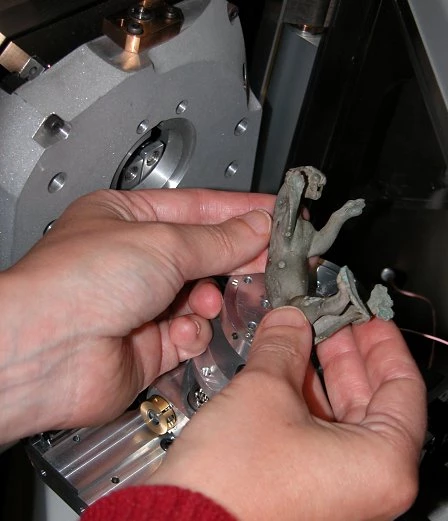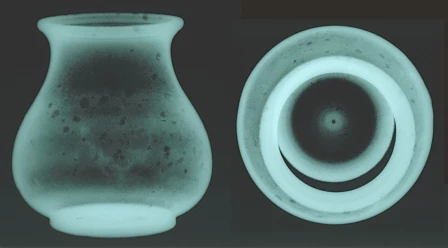Exquisite Roman treasure gives up its secrets
The leopard cup. 11.5cm (4.5 inches) tall.
Detail of the leopard handle, showing its finely worked features and silver spots.
Leopard cup being placed in the Scanning Electron Microscope.
X-rays of the cup.
Microphoto of the leopard's face.
Discovered in 2003, this exquisite Roman vessel has been the subject of detailed study at Amgueddfa Cymru - National Museum Wales.
The bronze cup is one of the finest Roman vessels to have been found in Wales. It was discovered by Mr Gary Mapps near Abergavenny (Monmouthshire). It was reported to the Portable Antiquities Scheme, enabling the finds spot to be investigated.
Excavation of the site revealed that the cup had been placed upside down in a small pit containing a cremation. This cremation was part of a cemetery beside a Roman Road some distance from the mid 1st to early 2nd century fort at Abergavenny (Roman Gobannium). There is also a growing amount of evidence for a civilian settlement dating from the 2nd to 4th centuries in the neighbourhood of this cemetery.
The cup displays craftsmanship of a high standard and it was almost certainly manufactured in Italy during the 1st century AD. Very similar cups have been found at the doomed city of Pompeii, which was destroyed after the eruption of Vesuvius in AD79.
X-rays of the cup revealed that it was first cast in a mould using leaded bronze. Lead was added to help the molten bronze (principally copper and tin) flow more easily and improve the quality of the casting. Once this casting had been made the vessel was turned on a lathe with the use of a sharp cutting tool to produce its final shape.
The cup's decorative handle depicts a leopard which, in Roman mythology, appears as the draught-beast and companion of Bacchus, the god of wine. His worship involved feasting, drinking, music and dancing. Leopards, captured in both Africa and Asia, were also popular with the Romans for display and fighting in the amphitheatre arena.
The leopard handle was made separately using 'lost wax' casting. The first process was to make a wax model of the leopard. A clay mould was formed around the model and then heated to run off the wax. Leaded bronze was poured in to fill the space left by the wax and, after cooling, the mould was broken to remove the bronze handle.
Further work was undertaken on the finished casting: for example the tail and canine teeth, originally cast thicker, were cut away to form finer features. The spots were also chiselled out from the body after casting and inlaid with silver. The leopard was then attached to the cup using solder. The leopard's eyes, measuring about a millimetre in diameter, were also inlaid. Analysis of the remaining traces of inlay indicate that the eyes may have been of amber.
It is unknown whether the cup belonged to a member of the Roman army, or a native Briton from the nearby civilian settlement. Whichever is the case, this 1st century cup was a costly import and probably belonged to someone of status, who cherished it sufficiently to want it buried with them on their death.
Background Reading
Things Fall Apart: museum conservation in practice. National Museum Wales Books, 2006





Comments - (2)
Hi there Brandon
Thanks for your message. We have updated the article to reflect your father's key role in the discovery of this amazing artefact.
Best wishes
Sara
Digital Team